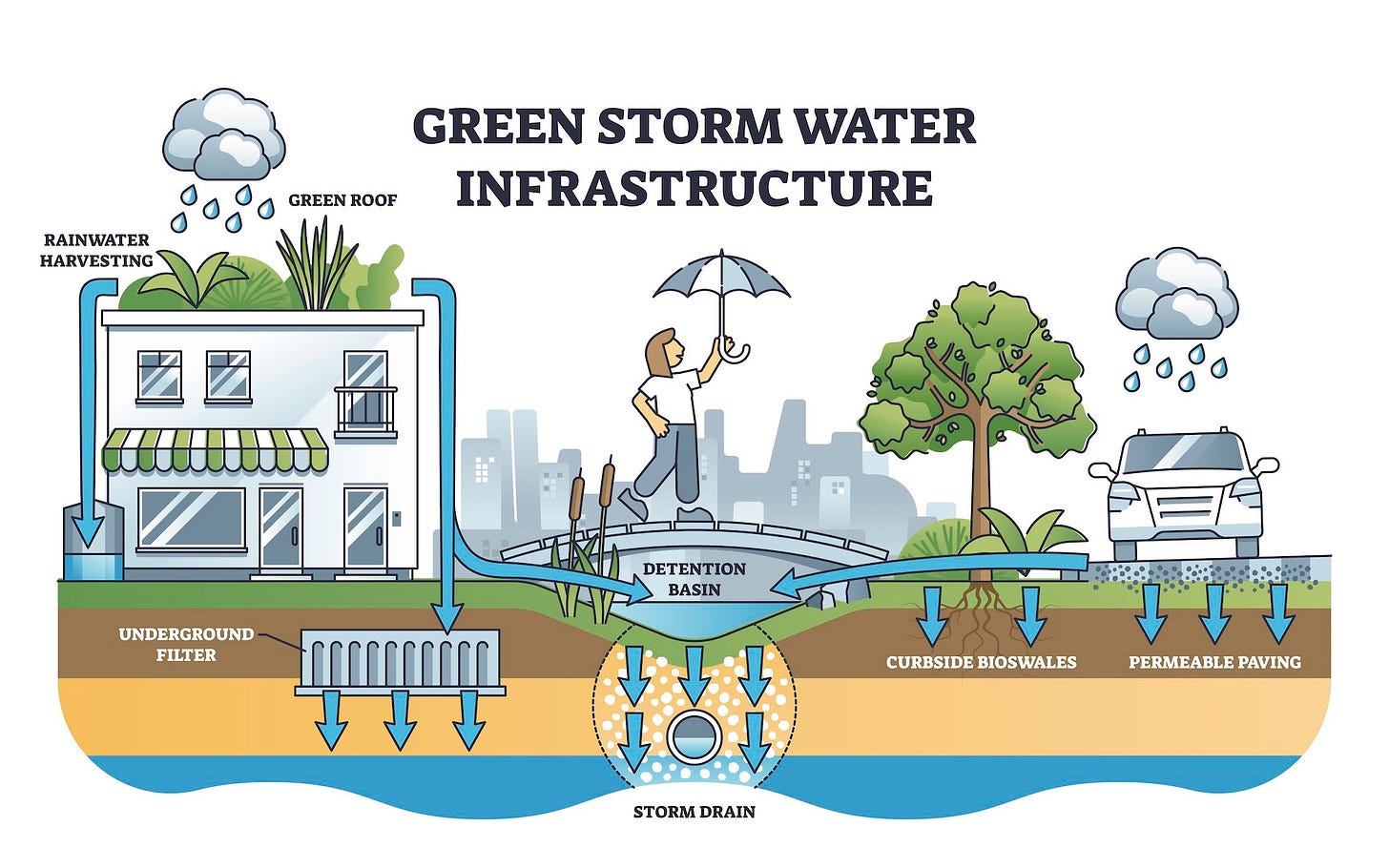How are Istanbul and Bilbao twins?
Last year, we had this cute little ditty where everyone was thinking about the Roman Empire. And me? I was thinking about it underground.
It might be insane to pull this comparison. One city is the heart of modern civilization and the other a small, artsy town. True, both are melting pots of cultures and history but they have one other thing in common…
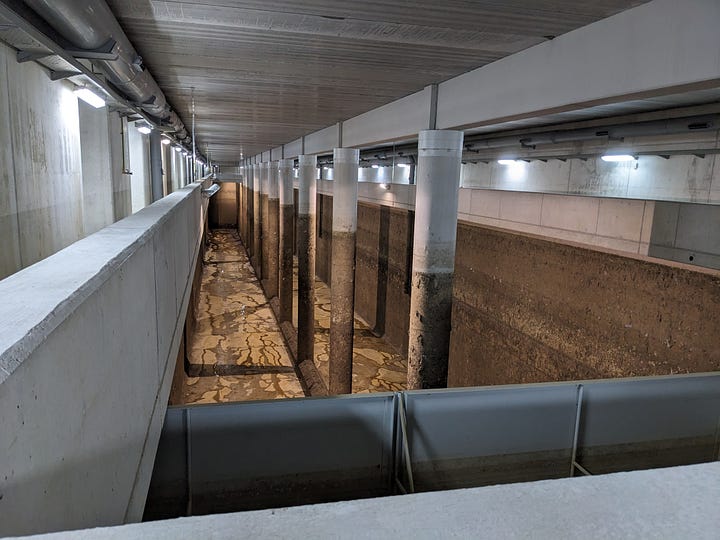

Too much water in not the right place
My boss loves to say, “You often think of water in happy pictures of people drinking fresh, clean water. But let me shatter that for you. Often water is too much, too little, not in the right place, not the right form, or not the right quality.” And that’s the essence of stormwater work. It’s too much in the wrong place. And rain? Not nearly as drinkable as the image in your head (or heard in some bottled water marketing.)
If you’ve ever stood next to a creek (but be safe!!) during a rainstorm, you’ll understand just how quickly water can fill a creek. A stormwater tank is a way to catch the water to either let it drain slowly back to the river when there is too much or to hold for treatment when its not the right quality.
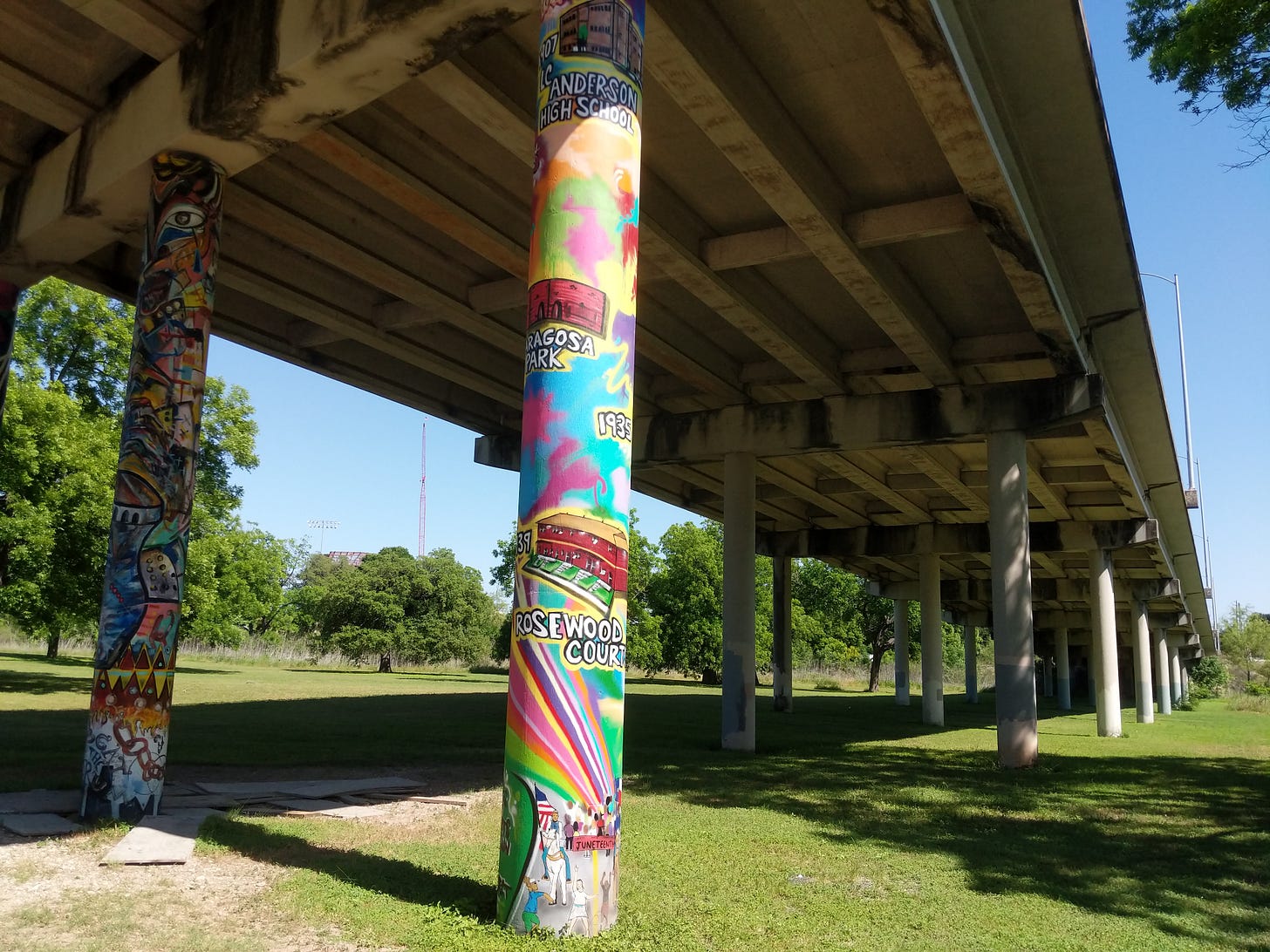
I’ve before discussed a watershed. In Austin I live in the Boggy Creek watershed where this picture was taken. It’s elevated out of the flood zone. In this case all this water that runs off the deck and down the slope either permeates into the ground or comes to the Boggy Creek which discharges at one point into the Colorado River and then the Gulf of Mexico. Because of this direct connection to the ecosystem, it is important that runoff is of good quality to protect waters of the US, per the Clean Water Act of 1972.
There’s a few instances where water quality in a river is poorer than other times. Immediately after a rainstorm it will pick up E. coli from dog poop and oil contaminants from cars. There’s also cases where there’s chemical imbalances, sediment and oxygenation, leading to algae growth and a couple of other water issues that I won’t cover today. All that to say, stormwater poorly affects water quality. It’s the reason that construction sites are required to post SWPPP signs at their entrances. Look for it the next time you pass a site.

Surely, there’s a design solution for stormwater?
At the global level, there isn’t a clear standard for how people do stormwater. I was talking with a Portugal client of ours and they said they just let it run off naturally. That works if it’s a region without much rain. Remember that it is sometimes better to under-design and fix in maintenance than to over-engineer a city into an unnatural (and expensive) landscape.
Some cities might have a separate department for stormwater or lump it in with sewer. In Austin, we have a “watershed department.” They cover anything from flood control to the slope stability around a creek. They might also design the hydraulic way water is routed through culverts or under trails.
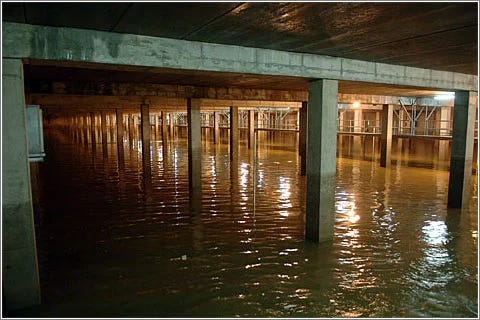
Look for a Drains to River storm sewer
When we have too much water, all at once it is called a wet weather event. This is an important term as it is how we design and discuss stormwater, but it just means rain. There are typically 2 designs: combined sewers or separated. You can tell by looking for a storm sewer that says “drains to river.” That doesn’t mean if you don’t see that plaque that it doesn’t drain to river. But they often mark them so that people don’t dump contaminants straight into the river.
Combined Sewers
This is typically an older design you might see in an older city. The benefit here was that you only need one set of sewer pipes and you then treat most of the water that comes into them. However in large storms (sort of like the ones we get in the 21st c) they may not be big enough or the treatment capacity at the treatment plant might not be big enough for that small amount of time when a lot of water is coming into it.
When this happens they will overflow gross, surface-contaminated water mixed with sewage to the river, bypassing the treatment process. The US and Europe is really starting to crack down on this as they are point-source contaminations at an outfall. In the US, we have the National Pollutant Discharge Elimination System.
Separated Sewers
On the other hand, a separated sewer has its own benefits and drawbacks. It’s more capital and maintenance costs. In a big storm, it’s likely that the river’s water quality is severely reduced. All the rain picks up the surface crud and transports it straight to the river. It’s why you should reconsider jumping into Barton Creek downstream of the springs after a major rain event.
Green Designs
There’s another way to do it - learning to live with water. Within the urban environment we can design small but mighty features that collect water. Stormwater curb extensions, bioswales, and permeable pavement are just a few ways to try to get water into the soil rather than the river. Obviously it only works up to a certain quantity of water.
Climate adaptation is the idea that we know climate is changing and we need to have designs that are meant for it. I have a post on this too.
Extebarri’s Best Tourist Spot
In my conference bag I had a little water drop shaped USB drive. On it was a beautiful video which you can see here about all the different types of water in Bilbao. It’s also on Youtube and a fun watch.
At the conference I then took the best tourist visit to…. the stormwater tank. This tank took about 33M Euros to build. It’s approximately 28 Olympic swimming pools. But who knows the volume of a swimming pool? It’s ~roughly~ 2 Guggenheim museums of capacity.
What makes me really excited is the ability to take stored water and then treat it for other uses - an ideology called One Water. In One Water you can use the different types to fix the problem of too much, too little, wrong type, wrong place. Excess stormwater is now…irrigation water. Or drinking water. Or whatever you want it to be.
A fun fact I learned is that in Spanish a river is rio but a saline river is ria. We call it an estuary in English. At the watershed level, they operate the pipeline with a couple of valves using the information they see from the instrumented piezometers (wells) nearby.
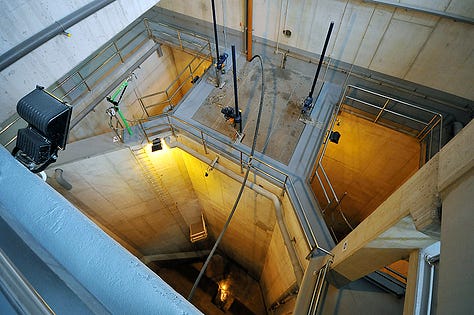

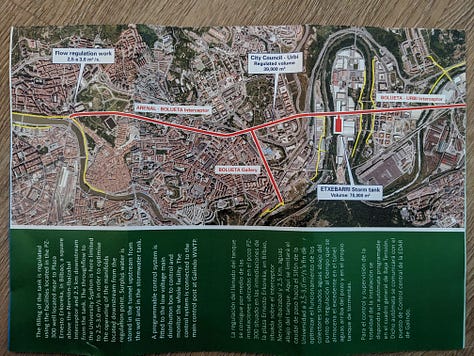
Water comes into the manifold and fills 3 chambers by gravity. You can see this feature in the video above. There are no gates on the individual chambers but instead there are slots in the wall that allow water to pour through. The slots are at different heights so that the chambers fill individually, and some not at all in smaller storms. On the third chamber, it can spill over into a fourth chamber.

There is a system here to flush out the chambers after it has been emptied. A vacuum holds the water in at the far side. After the event they release the water and let it flush everything out. In the case of the photo above, the chamber’s system broke and they had no yet used the secondary method of flushing with clean water.
In smaller tanks, they use a cradle system, where water fills the cradle which then rocks over to clean the tank. However this is too big of a system and they have to use the vacuum method here to hold the amount of water needed.
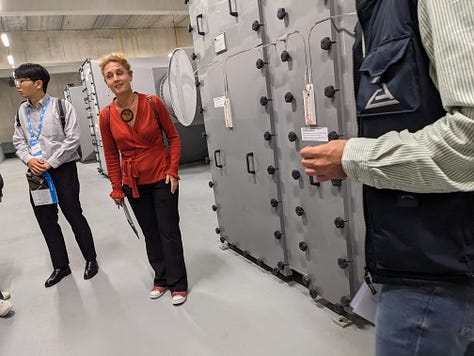
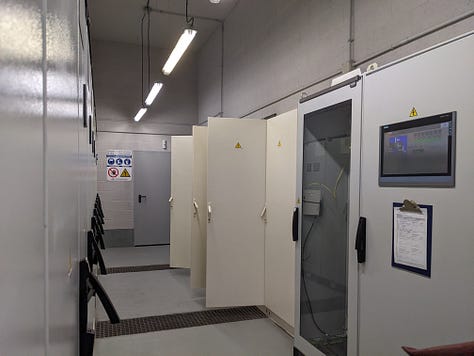

Another feature of the design is the ventilation. It is only necessary if you want to enter (for people) but also keeps the smell down in the neighborhood. It’s considered an auxiliary system. That means if the power goes out, it isn’t mandatory to keep online. In the photos above you can see the ventilation equipment and the control room.
There’s also a hydropower plant, using reservoir water, and a test facility for water treatment on the site. Neither are directly associated with the stormwater tank. One question I asked… if you have all this stormwater, then why the fake grass above the tank? The answer: for low maintenance.
So how is it the same as Istanbul?
After they finished the conceptual design, this team of women engineers realized that it has the same volume and dimensions as the Basilica Cistern built in 532 AD. They wanted to have an element that calls to the coincidental similarities with the tank in Istanbul.
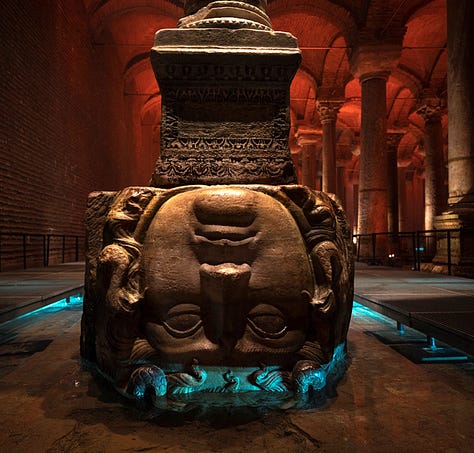

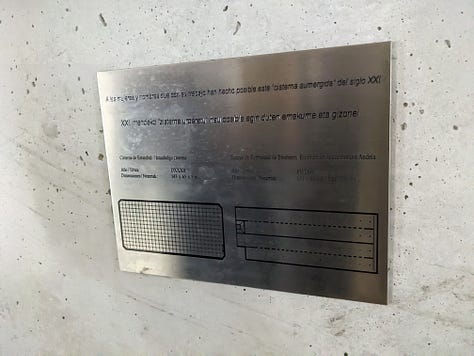
They also told us that there are 627 of these in the world. So then I wanted to know about others – as you can imagine googling “water cistern” and “stormwater tank” is a bit difficult. I did find one in Hong Kong that is just shy of the size of the Spain tank at 60,000 cubic meters. The design intent is to mitigate floods and then use to water the sports complex. Yay One Water! This one has moveable weirs for water management.


So if there’s one takeaway here, it’s that stormwater is a LOT of water in a short amount of time. It requires huge capital investment and even digital tools to help operate. And it’s only getting more complicated as storms are more intense.
But also that water infrastructure can make a great tourist destination. But you already knew that, right?
Reading: The Moon Is A Harsh Mistress. I wouldn’t honestly recommend it unless you’re a big sci-fi fan. The writing is hard to get into because they use “Luna” speak. But it’s quite fascinating how the world is built.
Here’s a recommended read on Bilbao re-inventing itself.
Listening: TEXAS HOLD ‘EM. Go Beyonce.
Working: Digital twins for water treatment plants! Which actually includes stormwater facilities that have pumps, pipes, valves and sometimes even advanced chemical and biological treatment.



